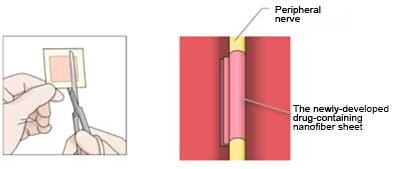A research group that includes Osaka University has announced the development of a drug-containing nanofiber sheet that wraps directly around peripheral nerves that have been damaged and promotes regeneration. The group has also succeeded in manufacturing the sheet on a scale applicable to surgery and will commence clinical trials soon. The sheet is expected to offer a new treatment for peripheral nerve disorders such as carpal tunnel syndrome, which is said to affect several hundred thousand people in Japan.
This research group's members include Hiroyuki Tanaka, Specially-appointed Professor, Graduate School of Medicine, Osaka University; Mitsuhiro Ebara, Group Leader, National Institute for Materials Science; and researchers from Nippon Zoki Pharmaceutical Co., Ltd. Using a specialized technique known as "electrospinning," the group created a nonwoven microfiber of a biodegradable polymer known as poly-ε-caprolactone (PCL), and furthermore infused the sheet with drugs that are a key factor in the regeneration of nerves.
According to the research group, this sheet is notable for being permeable to body fluids, but non-permeable to inflammatory cells such as macrophages that cause damage to nerves. As a result, by wrapping nerves in the sheet during surgery, they can be protected from post-surgery inflammatory response. Additionally, the sheet is extremely flexible, is soft and pliable to the touch, minimizes nerve stimulus, and can be cut to the required size in order to be stuck to or wrapped around nerves.

Because the drugs are distributed evenly in each fiber of the microfiber rather than simply being applied to the sheet's surface, they are released at a constant speed over a long period. PCL is designed to biodegrade slowly over a period of one year or more, so post-operative extraction is unnecessary.
When Tanaka and his colleagues used this sheet on a lab mouse with a sciatic nerve injury, in approximately six weeks the axons of the nerves regenerated, and motor function and sensory function were restored. Based on these results Nippon Zoki Pharmaceutical joined the research group, which set a course toward manufacturing a high-quality, stable sheet that would have clinical applications. The group says it has become possible to perform approximately 50,000 operations a year on patients requiring peripheral nerve surgical procedures. Clinical testing is scheduled to be carried out until June 2022.
Peripheral nerves extend from central nerves such as the brain and spinal cord, throughout the body to the hand and feet, eyes, skin, internal organs and so on. They perform an extremely important role by conveying orders from the brain to the hands and feet, and conveying the stimulus obtained by the eyes, ears, skin and similar organs to the brain. Medical products for the treatment of peripheral nerve damage have existed up to now, but they are only applicable to cases where the injured nerves have been completely severed. These products also pose problems because they employ stiff materials that are difficult to handle and are not effective in promoting the regeneration of nerves.
Original article was provided by the Science Portal and has been translated by Science Japan.




